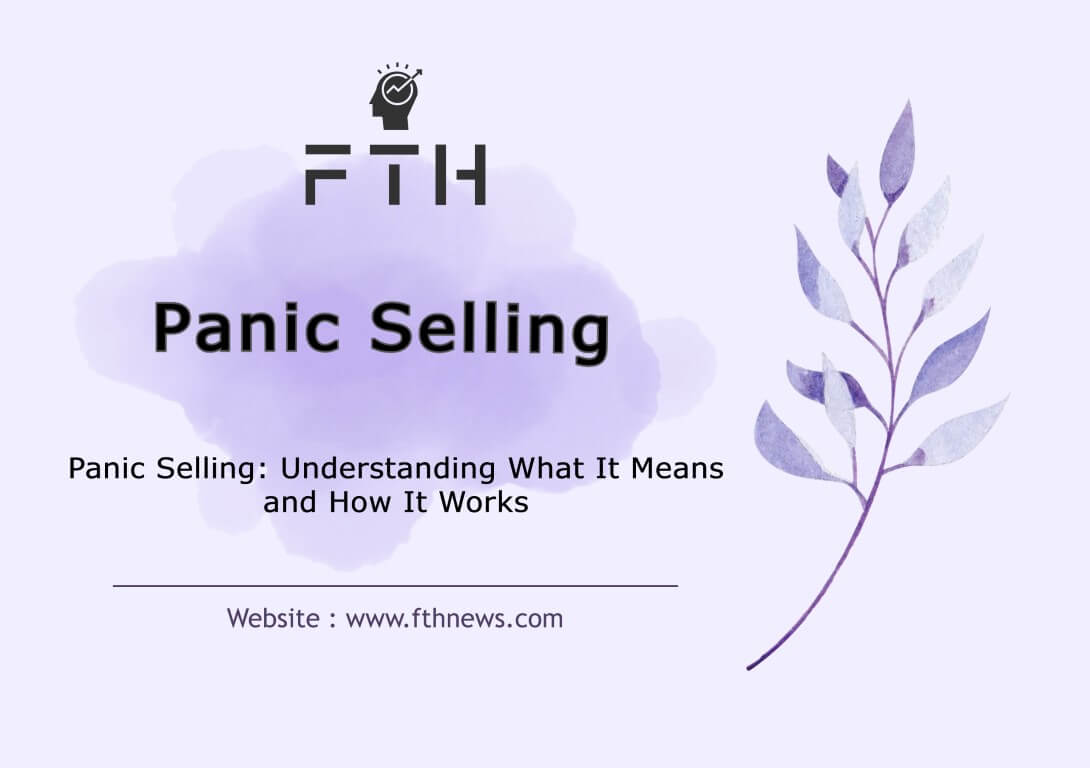
Panic Selling: Understanding What It Means and How It Works
Panic Selling,Trading psychology is a fundamental concept in the financial markets, and it revolves around the intricate web of emotions and feelings that can spell success or disaster for traders. Behind every profitable trade lies a timely and well-thought-out decision. However, the factors that lead to a sound decision are diverse and unique.
While knowledge and thorough research about an asset or currency play significant roles in determining the success or failure of a trade, the ultimate tipping point is often the trader’s psychology, particularly their emotions and feelings within the market.
One such emotion is greed, which is a central theme in the world of financial markets, often measured by the Fear and Greed Index. Greed can cloud rationality and judgment, compelling market participants to seek profit at any cost, potentially leading to incorrect decisions and, consequently, panic selling.
Understanding Panic Selling
Panic selling is a phenomenon commonly observed in the world of digital assets and financial markets. It occurs when individuals, gripped by fear, hastily offload their holdings as soon as the market takes a downturn. Typically, this group of sellers comprises novice traders and short-term investors who are averse to risk, preferring not to wait for prices to recover during a market slump.
For these panic sellers, the immediate goal is to minimize losses. Consequently, they are often the first to exit the market, even in response to a slight market dip. The rush to sell, driven by fear, can result in a rapid and substantial decrease in asset prices.
Paradoxically, this fear-induced selling can set off a chain reaction. Once the prices have fallen significantly due to the panic selling, other traders and investors, who were waiting for a price dip to make their purchases, seize the opportunity. Their buying activity often contributes to a renewed uptrend in prices.
In essence, panic sellers are akin to those individuals holding a snapshot of the market’s current state. Panic selling unfolds when a sizable number of traders abruptly shed their assets in a short time frame, causing a sharp decline in asset prices. The ensuing fear and anxiety may prompt more investors and traders to join the selling frenzy, further driving down prices.
The Role of Greed and Fear in Trading Psychology
Excessive greed is a common affliction among traders, often leading to emotional and irrational behaviors. This can result in risky decisions, such as investing in the unknown digital currency projects. Moreover, greed can lure investors and traders into extending their positions beyond the recommended threshold, in pursuit of greater profits. This aspect of greed is most noticeable during the final stages of bull markets when price predictions and speculations are at their zenith.
On the flip side, fear can prompt traders to exit positions more swiftly than advisable, causing them to overlook the potential for substantial profits due to an intense aversion to loss. It’s essential to understand that fear tends to be more prevalent in bear markets, driving traders to make hasty and irrational decisions.
In many cases, this overwhelming fear evolves into what we commonly refer to as “panic,” and this, in turn, triggers a substantial volume of selling in the market, aptly termed “panic selling.”
With this background in mind, our focus in this article is to delve into the concept of “Panic Sell,” exploring its various facets. However, it’s crucial to start with a broader framework – the psychology of trading, which forms the bedrock upon which the notion of panic selling rests.
Understanding Panic Among Market Investors
Panic selling in the currency market has the potential to artificially drive down the price of a digital currency. This decline happens as a result of a mass exodus of investors selling their digital assets in a frenzied response to market turbulence. However, it’s important to note that this price drop does not necessarily reflect a change in the intrinsic value or the quality of the digital currency project itself.
Even in the midst of a panic-driven sell-off, there will always be individuals or institutions ready to step in and acquire digital assets at the now-reduced prices, leading to a subsequent price recovery.
As we’ve discussed earlier, the initial price drop resulting from panic selling often triggers more panic. This can create a self-perpetuating cycle, where fear-driven selling feeds into further selling, compounding the downward pressure on prices. The consequences can be severe, potentially eroding a significant portion of investors’ assets. The recovery of an asset’s value following such a fundamental panic event may be a protracted process, taking months or even years.
The Irreparable Financial Consequences of Panic
Panic, particularly in the realm of financial markets, can spell high-risk scenarios leading to substantial losses. For those investing with long-term goals spanning years or decades, weathering a panic-induced storm may be challenging but generally manageable. However, individuals nearing retirement may find themselves in a precarious situation if a sudden bout of panic strikes just before their retirement years, especially if they intend to rely on these investments for their livelihood.
The prospect of a sudden market downturn serves as a prudent reminder for investors to periodically reassess their asset allocation as they approach retirement. Transitioning from riskier assets to more stable ones can help safeguard their nest egg.
Moreover, in acknowledgment of these risks, many financial experts advise individuals to maintain a reserve equivalent to six to twelve months’ worth of living expenses in cash. This serves as a protective buffer. Even if a financial crisis results in job losses, individuals can navigate through daily expenses while keeping a foothold in the market. This strategy aims to ensure that long-term financial plans are not compromised by the demands of daily life.
In essence, market declines, be it in housing, commodities, or currencies, typically occur when the number of sellers surpasses that of buyers. At times, panic can reach a point where the sheer quantity of sellers compels them to part with their assets at any price. When panic dominates the collective sentiment of investors in a market, it creates a heightened risk of a market crash.
Understanding the Causes of Panic Selling
Panic, in its essence, is a human reaction to the looming prospect of substantial financial losses. panic shares this characteristic, with the potential panic stemming from the fear of enduring significant financial setbacks. However, there are several contributing factors, each capable of individually sparking panic selling within the financial market.
Weak Hands
Within the market, the term “Weak Hands” is often used to describe individuals who lack skill, operate without a clear trading strategy, and engage in unplanned trading. Their actions frequently result in substantial losses due to insufficient market knowledge and a dearth of research.
In essence, many with Weak Hands contribute to the profits of more experienced market participants or those who employ sound analytical strategies. For someone to succeed in the market, someone else must endure a loss. Weak hands often fulfill this role; they tend to purchase a favored currency at high prices and sell it back at lower rates.
These transactions are the primary path to financial losses in the market. You might have heard that in the world of finance, wealth often transfers from the pockets of impulsive individuals to the pockets of those with patience and a deliberate strategy. Weak hands typically sell their assets hastily, often without due consideration of market news or a thorough analysis, transforming their holdings into digital currency. This impulsive behavior is far from wise. Moreover, they frequently adhere to self-imposed rules in the market, making their actions highly predictable.
Having predictable actions within an inherently unpredictable market remains an unwise approach. Weak hands are highly susceptible to stress as they react strangely to normal market fluctuations. Consequently, they become sellers in declining markets and buyers in rising, bullish markets.
There’s another group known as “Weak Hands” who view the market primarily as a speculative arena and do not consider themselves investors. The behavior of these two groups differs significantly. Speculators exhibit erratic behaviors in response to price fluctuations, while investors typically pay less heed to such market gyrations.
The Role of Stop-Loss Orders in Panic Selling
Certain trading programs have the potential to exacerbate the intensity of panic selling, and among these programs, one significant contributor is the stop-loss order. A stop-loss order is a predefined instruction to either buy or sell a specific asset once it reaches a predetermined price level.
On the surface, stop-loss orders can be an effective tool for capitalizing on the opportunity to purchase an asset at a discounted price when its value is in decline. However, during a sudden and steep market downturn, these orders often trigger automatic sales. If these automatic sales are of a substantial volume, they can have a effect, not merely slowing down the market decline but even potentially accelerating it, playing a significant role in the onset of panic selling.
Learning from the Mistakes of the Past
For years, the prevailing advice to avoid panic selling has been simple: “Don’t panic.” It’s a well-established fact that financial markets tend to rebound, even following significant financial crises and panic-induced downturns.
Yet, even for investors who manage to resist the urge to sell during turbulent times, periods of panic can still leave a mark on their wealth and financial plans. The extent of this impact largely depends on an individual’s investment style, their portfolio composition, and their risk tolerance.
In the near future, market fluctuations are expected to be a common occurrence. It’s crucial to steer clear of joining the ranks of those who hastily sell their assets due to fear. If your investment portfolio is well-structured, you can weather market downturns with resilience. If you are in the older, retired age group, you likely have sufficient capital to sustain the income you need. On the other hand, if you’re a younger investor, a market crash can present an attractive opportunity to acquire valuable securities at prices resembling a well-crafted auction.
It’s important to understand that the impact of panic selling on long-term savings is profoundly detrimental. This tendency represents one of the most significant mistakes investors make in the financial markets.
The Impact of Algorithms in Panic Selling
Algorithms, widely adopted by large financial institutions and professional investors, play a pivotal role in the dynamics of financial markets.
Among these algorithms, some are programmed to automatically trigger the sale of shares when their prices reach predetermined levels. These automated trading tools offer efficiency and precision, but they also introduce a unique set of risks, particularly when it comes to panic selling.
Historically, algorithms have left a significant mark on financial markets. Notably, they played a part in the stock market crash of 1987, with the advent of some of the first computerized trading programs.
Fast forward to 2010, when an unintended consequence of highly sophisticated trading software led to the “Flash Crash.” In less than an hour, this event wiped out nearly $1 trillion in market capitalization, serving as a stark reminder of the impact of algorithms on market dynamics, particularly during panic selling episodes.
Recognizing the potential risks posed by these automated trading tools to the entire financial system, most major exchanges have implemented a set of trading limits. These limits are designed not only to curb the influence of panic selling but also to provide users of these programs with an opportunity to recalibrate their strategies before panic takes hold.
Strategies to Thrive During Panic Selling
Amidst the tumult of panic selling, opportunities often arise as many investors succumb to irrational decisions, creating valuable openings for those who keep a level head. For instance, following major market crashes like the 1987 stock market crash and the 2008 financial crisis, the S&P 500 rewarded its investors with double-digit annual returns for a decade.
However, one of the challenges in such situations is the uncertainty of when the panic episode will conclude and the market will reach its bottom. Even professional traders equipped with complex mathematical models often yield mixed results in predicting market rebounds. For the majority of investors, even those who are well-informed, it often remains a guessing game at best.
In this context, there are two key solutions to navigate panic selling successfully:
1. Stay Calm: The first and perhaps the most critical solution is to resist the urge to panic. Maintaining composure during market turmoil is essential.
2. Keep Buying: The second solution is to continue buying during market downturns when assets are available at significantly reduced prices. While pinpointing the market bottom is challenging, a consistent buying strategy during low points can be a prudent approach.
Dollar Cost Averaging: Dollar cost averaging is a valuable technique that can be employed during panic selling. In this long-term strategy, investors purchase a fixed amount of an asset on a regular basis, such as monthly. This approach allows investors to acquire assets at lower prices during market downturns and reduce investments when prices are higher. It’s a strategy that not only functions effectively during periods of panic but remains a reliable solution for all seasons.
The 2008 Financial Crisis: A Notable Case of Panic Selling in America
As a trader, the panic of others can significantly impact your own assets, especially during turbulent times. The year 2008 provides a striking example in the form of the great recession, where the American stock market plummeted by about 40% in a mere six weeks. This colossal fall triggered widespread panic across the nation.
During this period, even those who typically paid minimal attention to the stock markets found themselves closely monitoring the news. The majority of people were gripped by fear and anxiety, concerned that the economic system’s impending collapse could plunge the entire American economy into severe turmoil, affecting them individually.
It’s common to witness investors succumbing to panic in financial markets, with major global events often serving as catalysts. The market upheaval in March 2020, triggered by the rapid spread of the coronavirus pandemic and widespread quarantine measures, serves as a more recent example.
Panic can also arise from the unrealistic valuation of a particular asset, such as the housing market bubble in the United States in 2008. A swift shift in public perception about the asset’s value, decoupling it from its intrinsic worth, can initiate a panic.
In 2008, the American banking system faced near collapse, and the efforts to rescue Merrill Lynch echoed the looming peril faced by many other major American corporations. This dire scenario prompted an immense panic, ultimately leading to an unprecedented wave of panic selling in financial markets. It can be considered the most significant instance of panic selling in the financial markets over the last three decades.
During this period
During this period, people sought to offload their shares at any price, often selling at significant losses. The frenzy of panic selling created a chasm between rational decision-making and emotional responses. Psychological scars from that time have left many individuals struggling to discern when it’s safe and opportune to re-enter the market.
Before the panic sellers began buying again in earnest, the market, which had previously fallen by approximately 38%, embarked on a recovery journey, rebounding by 10%, then 20%, and eventually more than 30%. Those who refrained from rash actions and maintained a patient stance might have only lost a few months or a year or two, but in the long run, they managed to recoup their assets and profits. While it might have meant a delay for those planning their retirement or nearing financial independence, the end goal remained achievable.
As a result, those who contributed to the panic selling during the 2008 financial crisis may have never attained financial independence and struggled to fully recover their assets. It’s noteworthy that history sometimes repeats itself, with some individuals failing to learn from the past. The same pattern emerged during the market crash at the onset of the coronavirus pandemic.
While sudden market declines may be unnerving, one of the greatest risks is surrendering to fear and becoming part of the selling frenzy. It’s vital to remember that financial markets consistently experience price fluctuations, and investors only truly suffer when their actions are driven by emotions.
In Conclusion: Navigating the Turbulence of Panic Selling
In the world of trading psychology, emotions like greed and fear stand in stark opposition. While, when balanced with proper control, they can lead to sound decision-making, either one in isolation can wreak havoc on an individual’s capital. The key, then, lies in mastering emotional control and making well-considered decisions that align with prevailing market emotions.
Panic selling, however, remains a complex phenomenon with often unclear and unpredictable triggers. During these turbulent periods, even seasoned investors and traders can stumble, as sudden market downturns challenge the best-laid plans. Nevertheless, it’s vital to recognize that while tuberculosis panic represents a real risk, it can also unveil profitable opportunities.
For investors, the essential strategy is regular review of their trading plans, ensuring their resilience through market turmoil. Even in the face of market declines, maintaining the course towards their financial goals is paramount. After all, in the world of finance, consistency and rationality often prove to be the ultimate assets.














